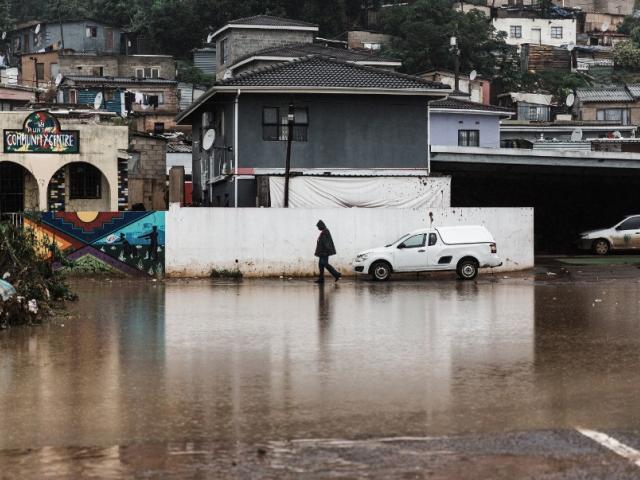-
The viral claim can be attributed to media site Bloomberg, who in turn said they had quoted the presidential climate commission. But the commission says it was misquoted.
-
“Current emissions data” that would prove this claim correct is not yet available and only likely to be so two years after the fact, as the commission confirmed for us.
-
According to environmental experts and international trackers South Africa is not in line to meet its emission targets.
South Africans are all too familiar with load shedding – planned power cuts when electricity demand exceeds supply.
Data shows that the country has had more load shedding in the first eight months of 2023 than in previous years. Many, including the government, have bemoaned the situation. But is it possible that load shedding has some benefits?
According to several posts circulating on social media, the power cuts have slashed greenhouse gas emissions and helped South Africa surpass its greenhouse gas reduction target.
Many of the posts attribute the claim to an article by Bloomberg, the US financial news and media company, with the headline South Africa Beats Climate Goal as Blackouts Slash Emissions.
But does the available evidence show South Africa’s electricity crisis has led to such a significant outcome?
Understanding climate change and greenhouse gases
Climate change is the long term shift in average weather patterns across the world. The changes lead to extreme weather conditions such as floods, heatwaves and droughts, rising sea levels and species extinction.
While this change can be natural, according to the United Nations (UN), human activity, such as the burning of fossil (natural) fuels, is the driving force behind current climate change.
Fossil fuels, such as coal, oil, and natural gas, are made from decaying plants and animals found in the Earth’s crust. Burning fossil fuels for heat and energy over the last century has led to a long-term increase in the Earth’s overall temperature, known as global warming. This is because burning fossil fuels produces greenhouse gases, which trap heat in the atmosphere and act like a blanket around the planet.
The main greenhouse gases are carbon dioxide (CO2) and methane.
Presidential climate commission is source of claim, says Bloomberg
We asked Bloomberg for evidence that South Africa had beaten its climate goal.
Antony Sguazzin, who wrote the article, told us the claim was not based on data, but was a direct quote from the presidential climate commission. The PCC is an independent body established by South African president Cyril Ramaphosa to drive the country’s transition to a low-carbon economy.
Crispian Olver is the commission’s executive director. In the article, he is quoted as saying: “We reckon we are well within the range of meeting the 2030 target.”
South Africa is part of the 196-member Paris Agreement, a legally binding international treaty that aims to limit the increase in the global average temperature to below 2°C, preferably to 1.5°C, compared to pre-industrial levels.
All countries in the treaty have to put forward nationally determined contributions, or NDCs, where they show the specific steps they will follow to reduce their greenhouse gas emissions and to adapt to the changes.
South Africa entered its first NDC under the treaty in 2015. The country committed to reducing its emissions to between 398 and 510 megatonnes of carbon dioxide equivalent (Mt CO2-eq) by 2025 and between 350 and 420 Mt CO2-eq by 2030.
Carbon dioxide is the primary anthropogenic, or human-made, greenhouse gas. It is the reference gas against which other greenhouse gases are measured, leading to the term carbon dioxide equivalent (CO2-eq).
South Africa strongly relies on coal-based energy, which contributed an average of 91.8% of total carbon dioxide emissions between 2000 and 2015. In 2021, coal contributed 86% of the country’s total electricity production.
Head of commission was misquoted
We asked Olver whether he had been quoted correctly and whether the commission had any data to back up the claim.
“The statement I made … was that the emissions were most likely within the NDC range, due to low energy availability factors and load shedding,” Olver said.
He said the Bloomberg article quoted him as though he had said the country was within the NDC range and also didn’t make clear that he did not specify which NDC target range – 2025 or 2030.
“My statement was based on the original modelling work we had done for the NDC and the assumptions that went into this about EAFs.”
The energy availability factor (EAF) is the maximum energy availability minus the total unavailability, expressed as a percentage.
For example, there would be maximum available energy if all the country’s power stations were running at full capacity. But energy is often unavailable due to planned or unplanned outages for maintenance, faults, load reduction or load shedding.
This calculation does not include renewable energy (such as solar power), independent power producers or imports of energy.
‘Many variables at play’ in determining current emission values
Steve Nicholls, the PCC’s head of climate mitigation, sent us a comprehensive report with data to support their statement.
In the report, the PCC said that there was a time lag in emissions inventory data. South Africa emitted 450 Mt CO2-eq in 2020 and so would be within the 2025 NDC range (between 398 and 510 Mt CO2-eq) if it maintained its emissions at this level.
However, this would still be slightly above the desired range for 2030, which is between 350 and 420 Mt CO2-eq.
Citing figures for the state-owned power utility Eskom specifically, the report noted the energy utility emitted 213.2 Mt CO2-eq in 2020. According to the PCC, there aren’t strong indications that this figure has increased since then. In Eskom’s 2022 sustainability report, emissions for 2022 are estimated at 207 Mt CO2-eq.
The decline in national emissions, according to the PCC, would be due to the compounding effects of decarbonisation efforts, load shedding, economic stagnation and the impact of Covid-19 on the economy.
But the commission added that this was speculative because current emission values were not yet available and “there are many variables at play which are subject to uncertainty”.
Because the actual data in the emissions inventory would only be issued two years after the fact, there would be a wait of one or two years for factual confirmation, Olver told Africa Check.
Overall rating still considered ‘insufficient’
Jasper Knight is a professor of physical geography and geoscientist in the school of geography, archaeology and environmental studies at the University of the Witwatersrand in Johannesburg.
He told Africa Check that South Africa was not on track to meet its international commitments. He referred us to the Climate Action Tracker (CAT), an online database that tracks how many countries have met their NDCs and are on course to meet the globally agreed goal of keeping warming below 2°C.
The tracker shows that South Africa’s overall rating is considered “insufficient”. This means that the country’s climate policies and commitments need “substantial improvements” to be in line with the Paris Agreement’s 1.5°C temperature limit.
According to the tracker, while South Africa’s updated 2030 NDC target is rated as “almost sufficient”, it is “insufficient” when compared to its fair share contribution to climate action.
A country’s fair share contribution is calculated based on its capacity to address emissions and its historical responsibility for causing them.
This graph from Climate Transparency, a global partnership including organisations such as the World Bank and the International Climate Initiative, shows that South Africa is not on track to meet the 1.5°C reduction.
Reduction in electricity consumption and declining economy impacting reduced emissions
Asked where load shedding fits into the picture, Knight said the current energy crisis had not led to a reduction in emissions.
“Load shedding takes place where the amount of energy being produced is diverted from one area to another. In other words, the first area experiences a blackout while the second area does not.”
In this process, there wasn’t a decrease in energy output, and therefore emissions, he said. “This is nothing to do with emissions but rather the impact of irregular and sporadic power supply on the economy as a whole.”
The high intensity of load shedding over the last few years had two impacts when it came to reduced emissions, Romain Pirard told Africa Check.
Pirard is an environmental economist in the School for Climate Studies at Stellenbosch University in South Africa.
These, he said, were a general reduction in electricity consumption and a decline in economic activity.
But ‘what happens to emissions reduction when load shedding ends?’’
Godwell Nhamo is a professor at the College of Economic and Management Sciences at the University of South Africa and specialises in climate change governance.
“From a common-sense perspective, the South African government didn’t plan to utilise load shedding as a part of meeting the emissions targets,” Nhamo told Africa Check.
“As such, it is not plausible to indicate South Africa is meeting its target through load shedding. The bigger question becomes, what happens to emissions reduction when load shedding ends?”
Conclusion: Claim takes fossil fuel emissions out of the environmental context and isn’t backed by available data
Several social media users recently claimed that load shedding had caused South Africa to “beat” its emissions reduction target.
They based their claims on an article from the financial news company Bloomberg.
But this is misleading, experts said. There are important qualifications to the statement, and data that would confirm the accuracy of the claim has not yet been published.
Experts told us that load shedding can contribute to a general reduction in electricity use and economic activity. But this does not mean that the power crisis is directly responsible for “slashing” emissions on a scale that puts the country on track to meet its global reduction pledges.









Add new comment